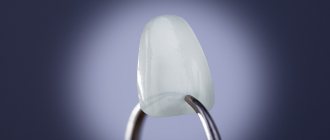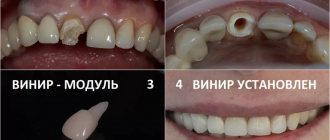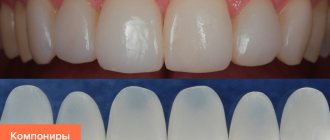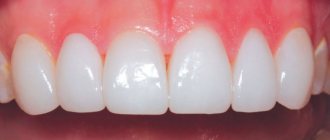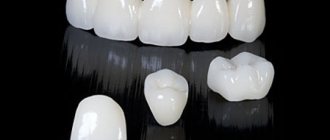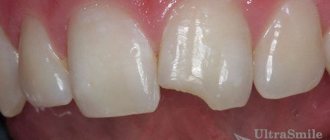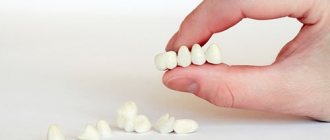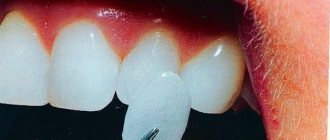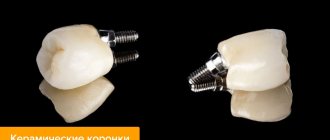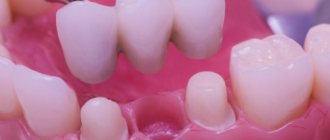In the age of selfies, video conferencing and presentations, a smile takes on special significance. Beautiful, straight and snow-white teeth – this is the beauty standard of the 21st century. But what should you do if your teeth are not so straight and their color leaves much to be desired?
Special thin overlays on teeth – veneers – come to the rescue. They mask dental defects, and the colors of dental veneers can be selected taking into account individual preferences.
Veneering is a correction of a smile using thin overlays on the teeth.
Veneering allows you to:
- hide chips and cracks;
- camouflage pigment spots;
- visually enlarge small teeth;
- cover gaps between teeth.
An important advantage of veneers is the ability to change the color of teeth.
How to choose the color of veneers
Choosing the right shade for the overlays is perhaps the most important part of the process. You can make veneers ideal in shape, carefully convey the details, but without the right color you will not get a satisfactory result.
Teeth onlays are made from materials that have properties as close as possible to natural enamel. This means that they have (to a greater or lesser extent) the ability to transmit light - to shine through. Therefore, the color of the dentin (the layer under the enamel) will be reflected in the final color of the plate. The shade of the cement on which the veneer is fixed will also make its contribution.
The colors of ceramic veneers are selected using the Vita scale
. In total, it contains 20 colors: 16 of them are natural, and 4 are ultra-white (Bleach). Bleach is an unnatural color; there are no natural teeth of this color.
There are 4 blocks in the scale, each with its own shade:
- Block A
includes red-brown shades - Block B
- yellow-red - Block C
- grayish - Block D
- gray-red
Decoding shades shouldn't be scary. In fact, they all look like natural enamel, and the designations are only important for specialists.
The main characteristic of color is brightness. Therefore, each block presents 4 degrees of brightness of each shade. From the brightest, it is indicated by the number 1, to the dimmer, under the number 4. The color of the veneer is a1
means that it should be the brightest color in the reddish-brown range. There are no shades in the bleach color of veneer 1 or 2, only white. There is a certain amount of yellow in Bleach 3 and 4, but the entire palette immediately speaks of the artificial origin of the color.
Aspects of Shade Determination
When consulting with a doctor on the issue of prosthetics and whitening of dental elements with cosmetic plates, it is recommended to carry out a comparative analysis procedure using the standard Vita palette.
Particularly popular today are instruments from the leading company Ivoclar Vivadent , which offers dental clinics innovative products to achieve the most effective and aesthetic results. The palette from this manufacturer includes the most natural white shades.
In the absence of such a device, dentists often resort to computer technology, the potential of which also makes it possible to correctly select the color of teeth in accordance with the downloaded digital photo of the patient.
However, despite the capabilities of programmable electronic computing devices, practical experience has shown that a visual comparison of shade matching produces a more effective and accurate result, especially since such a procedure can be carried out in any dental clinic.
Important! The shade of an element of the dentition is determined by three points - the cervical area, the middle of the crown, and the incisal edge. Careful assessment of color in all these areas is very important because... the enamel surface on different parts of the crown has different tones.
The color difference is influenced by the condition of the gum tissue, the dental unit itself and the structure of the enamel.
In order for the result of prosthetics to please the patient and not raise questions and dissatisfaction regarding the discrepancy between the comparison of shades and the result, the procedure for choosing the optimal color should be carried out under certain conditions, namely:
- Double teeth cleaning . Before visiting the doctor, the patient must perform thorough hygienic teeth cleaning. The doctor performs a control cleansing in his office using a special composition.
- Daylighting. The selection of shade is carried out only in natural light. Artificial light sources emit predominant shades, so determining the color of teeth will have errors.
Illumination is measured using a lux meter. Optimal values are 1200-1400 lux. Many dentists' offices are equipped with solar light units.The brightness of the lighting on such systems is adjustable, thereby creating optimal conditions for assessing the color of teeth.
- Suitable decoration for a dental office. The white tint reflects more than it absorbs.
In order to correctly assess the natural color of teeth, the interior of the office should not be too intense (saturated) in color, attracting a lot of unnecessary attention. It is desirable that the walls have a calm color in light colors.
Various elements of clothing can also distort the result of selecting a shade; for this reason, before selecting the most suitable color of veneers, it is important to take into account all factors that can affect the matching results.
- Proper hydration of teeth. The dry protective layer of teeth has weak light reflectivity compared to wet surfaces, so this detail is also important to take into account.
- Emotional state of the dental client. Most experts are inclined to believe that the natural perception of the shade of the elements of the dentition is influenced not only by external factors, but also by the mental state of the patient.
Therefore, one of the main tasks of a doctor is to provide a comfortable and mutually supportive environment.
For reference! Ceramics are close to tooth enamel in all properties. Veneers made from this material have excellent optical, structural, mechanical, biological and strength characteristics. Such products are also capable of transmitting, reflecting and absorbing light.
The secret of the popularity of zirconium veneers and their service life.
In this publication, we will find out how long teeth hurt after installing veneers.
Here https://www.vash-dentist.ru/protezirovanie/nesemnyie-p/viniryi-np/duo-pch-estestvennaya-krasota.html all the most important things about Duo PCH veneers.
Emax veneer color
Emax glass ceramics differ in their properties. Therefore, 3 parameters are used to designate its shades. Color scale, Vita 3D Master, includes:
- Brightness
_ Measured on a scale from 1 to 5 - Tone
. R – reddish, L – yellowish and M – intermediate - Saturation
. Use numbers from 1 to 3.
Thus, the color code consists of 3 symbols, 2 numbers and one letter.
Classic B1 for Emax is designated as 1M1.
The color palette in 3D Master is wider. It includes 26 natural shades and 3 ultra-white (Bleach).
The most popular colors
Bright shades are the most popular. Most often, patients choose shades a1, a2 and b1. These teeth look natural, but at the same time immediately attract attention with their color. Bleach is the choice of popular people. In the spotlight, on the TV screen, bright white teeth look attractive. It’s not for nothing that these colors are called “Hollywood white.” In real life, such shades hurt the eyes a little.
What is the Vita scale used for?
When to install a light-curing filling. It is especially important to correctly guess the shade on the front teeth: if the doctor uses too white material, the tooth will look unnatural and different from its “neighbors.”
In addition, the scale is used in prosthetics. And during microprosthetics, when it is necessary to apply veneers to teeth, and when making crowns, and when installing an entire prosthesis instead of a tooth that the patient has lost - in all these cases, the dentist measures the color using the Vita scale.
Difficulty of choice
The choice of color depends on the number of restorations. For single teeth, it is important to choose a shade so that the restored tooth does not stand out. If the plates cover the entire visible dentition, then everything depends on the wishes of the patient. However, the dentist should explain the main approach to how to choose the color of veneers:
- Skin, hair and eye color
must be taken into account . The lighter the skin and hair, the less the teeth, even radically white ones, will stand out. - Eyes and teeth
are the first things people pay attention to. Dentists recommend choosing shades that match the whites of your eyes. - The size of the veneers
plays a role. Ultra-white colors visually enlarge the veneers, so for large teeth it is better to choose natural-colored veneers.
What helps you choose the color of veneers
- Illumination
. The room should be adequately lit. Bright light encourages you to choose lighter shades, dim light encourages you to choose darker shades. - Removing plaque
. Professional teeth cleaning lightens them slightly, which affects the choice of shade. - Lack of bright colors
in the area where the selection takes place. Bright lipstick, makeup, and clothing details can disrupt color perception. - Wet surface
of teeth. The shade of moistened teeth is the most accurate.
Large clinics, such as ROOTT MCDI, use digital smile technology - Digital Smile Design
. The patient can see the results of the treatment even before it begins. This makes choosing the color of the overlays much easier and reduces frustration. If there is no such technology in dentistry, then the sample is brought to the teeth and a photo is taken to evaluate the appearance.
Care
Despite the fact that the material for making veneers was selected taking into account the effects of the alkaline environment of the oral cavity, sudden changes in temperature (hot drinks, ice cream, environmental influences, chewing loads), it is advisable not to forget that even real tooth enamel cannot withstand such loads and begins to collapse.
In this regard, you need to remember to care for veneers in order to extend their shelf life and preserve the original color. Moreover, veneers do not require special care; daily teeth brushing and infrequent visits (1-2 times a year) to the dentist are sufficient.
Additional conditions of care include some restrictions:
- Avoid drinking very hot drinks and ice cream
- Do not bite nuts or peel seeds.
- Limit your consumption of strong tea, coffee, as well as other drinks and products that contain persistent pigment, since traces of pigmentation tend to accumulate over time.
Sources used:
- Abolmasov N. G., Abolmasov N. N., Bychkov V. A., A. Al-Hakim “Orthopedic dentistry”, M., 2003
- THE BRITISH SOCIETY FOR RESTORATIVE DENTISTRY. "CROWNS, FIXED BRIDGES AND DENTAL IMPLANTS GUIDELINES"
- Notes of a good dentist / E.G. Aghajanyan. - M.: Omega, 2011.
Composite veneers
The color of composite veneers is able to convey the shade of natural enamel. But the type of finished product largely depends on the skill of the doctor. Since the composite is applied in layers, the dentist uses different shades, from darker to lighter, and the result is an imitation of a natural tooth. Composites are strong, they are used for veneers and restoration of dental crowns, but they are inferior in strength to ceramics.
Photopolymer overlays fade over time
, so the initial shade should be lighter than the desired one. When installing composite veneers, you should keep in mind not only the price, but also the service life. It is several times shorter for composites than for ceramics, including due to the fact that composites change color.
Treatment of dental caries with a microscope
Large fillings in chewing teeth were installed a long time ago; many fillings are no longer airtight, so caries has developed under the fillings. Dentist-endodontist T.I. Matienko treated dental caries using a microscope.
The use of a microscope helps treat caries microinvasively, removing only tissue damaged by caries and preserving tooth tissue as much as possible. After caries treatment, the teeth were restored with light-cured composite fillings. In the future, the teeth will be covered with crowns, which will strengthen them and prevent splitting due to high chewing load.
